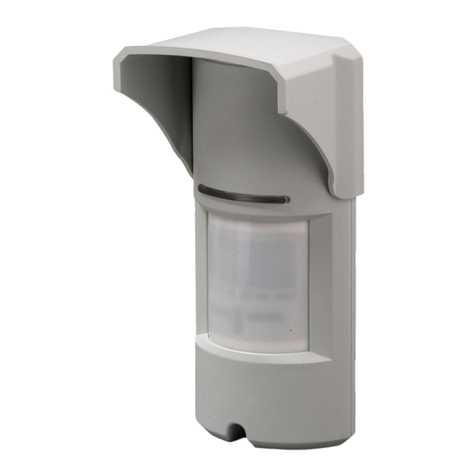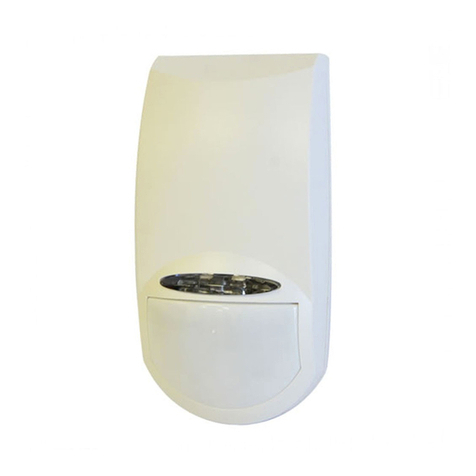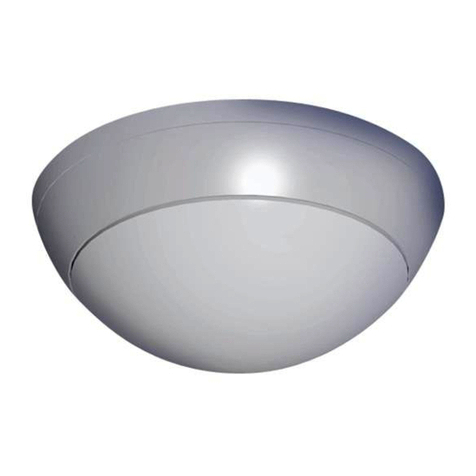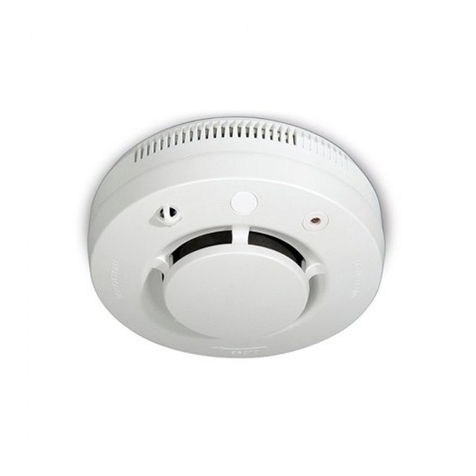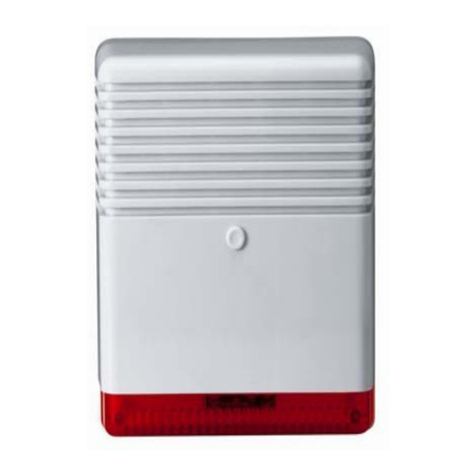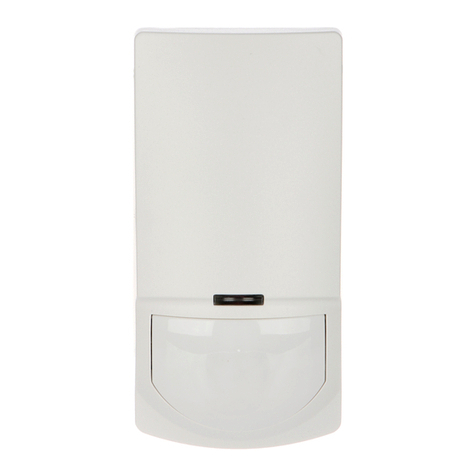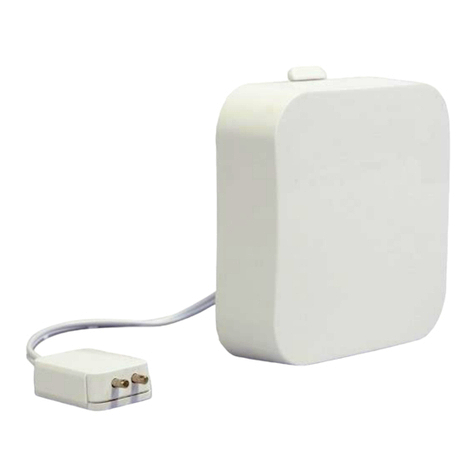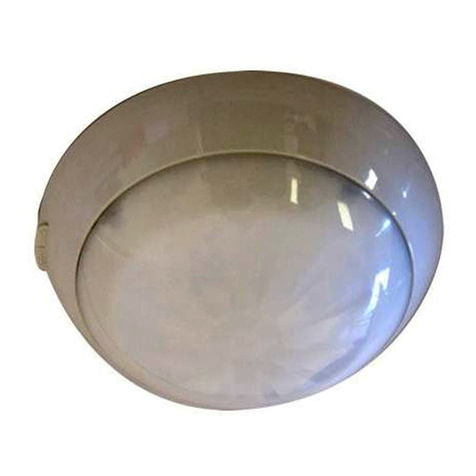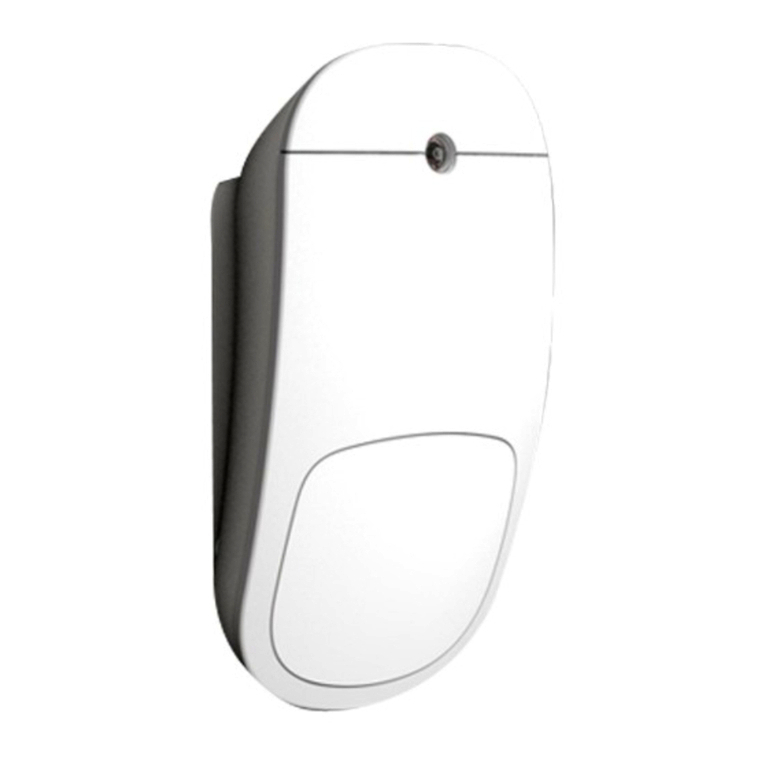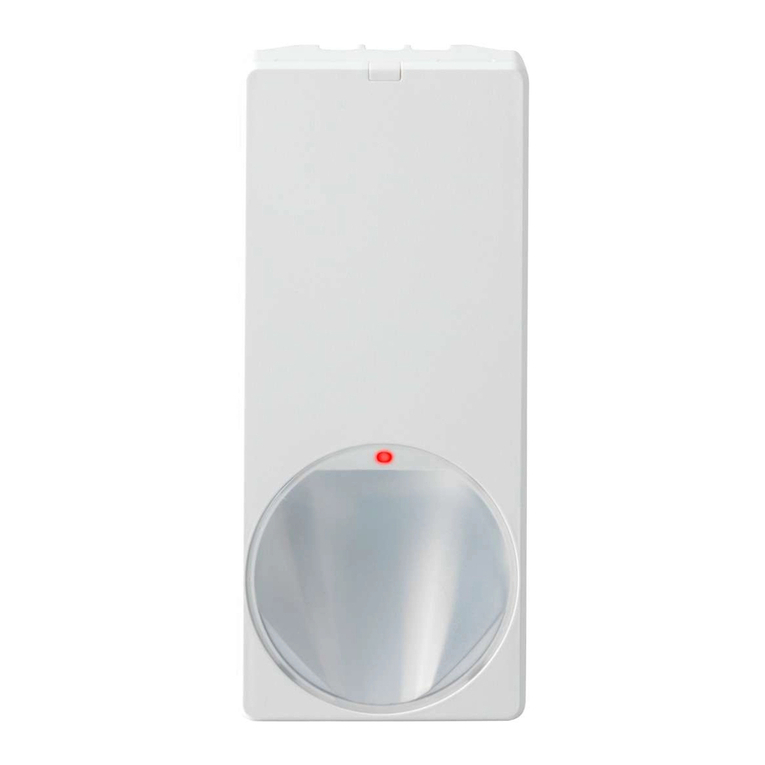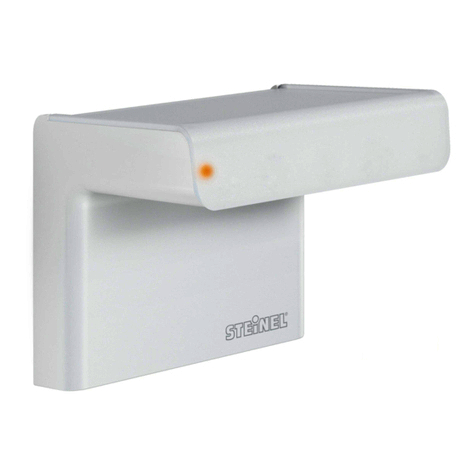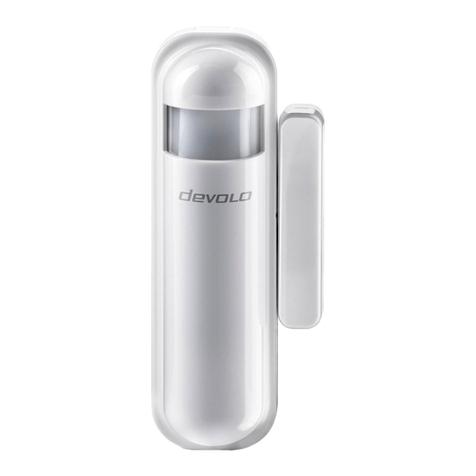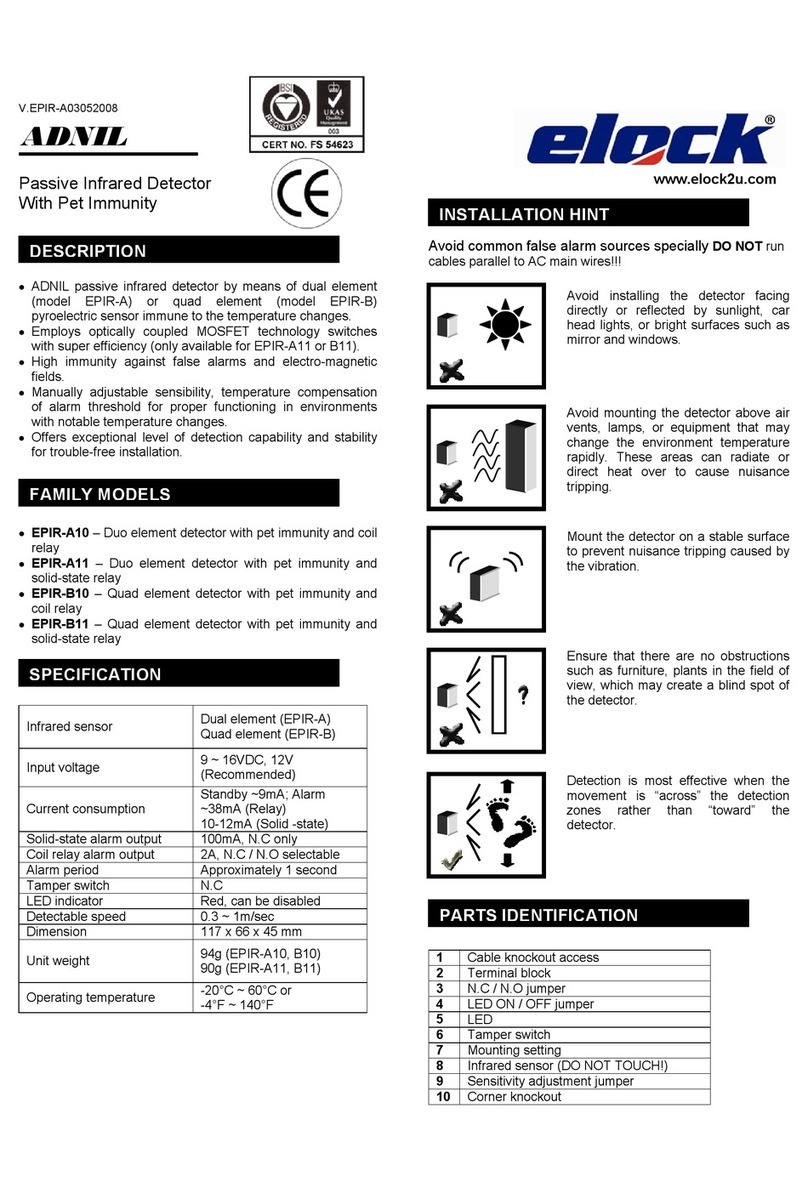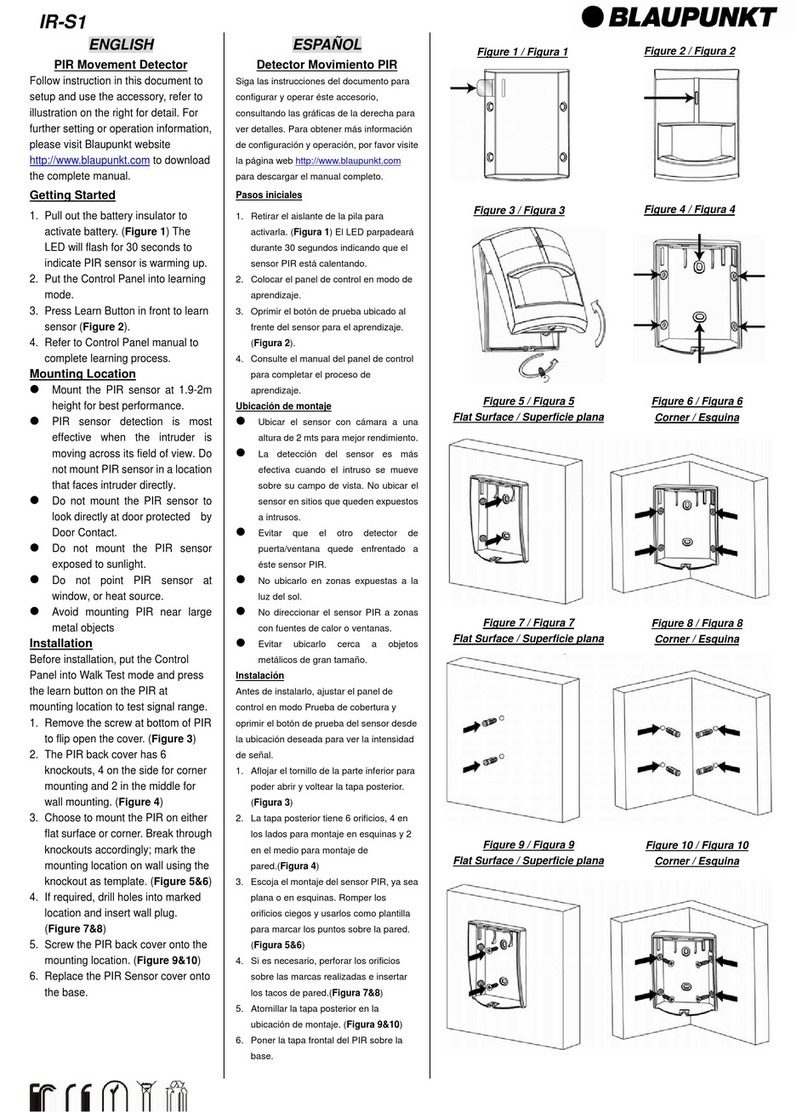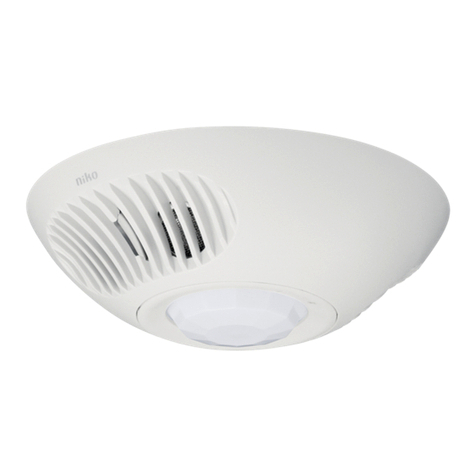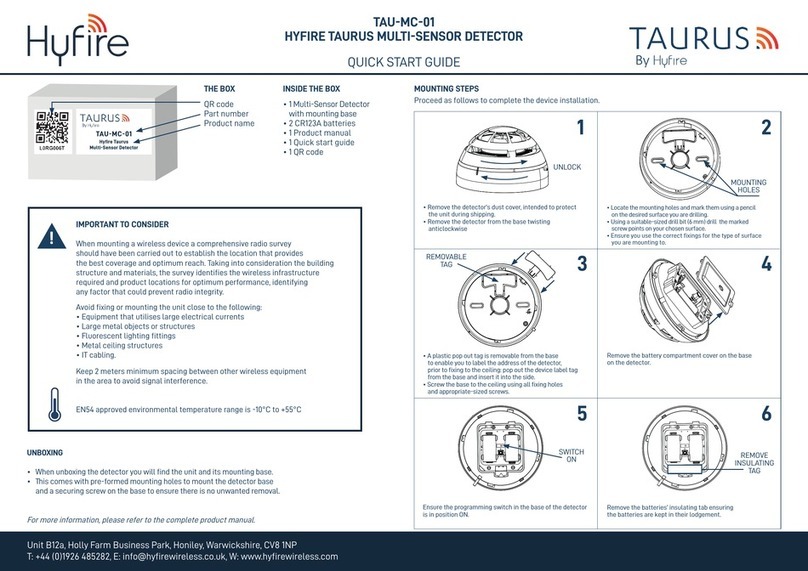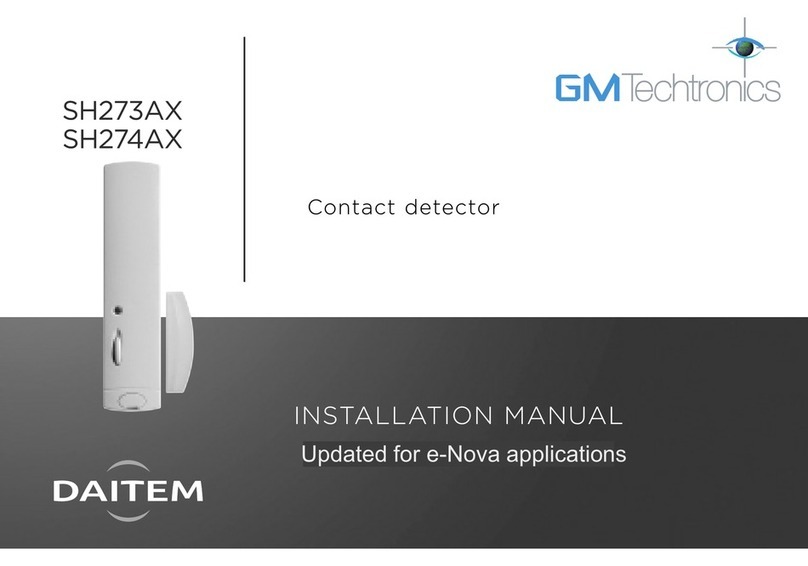Crow GENIUS Setup guide

1 2 3
CROW SCIENTIFIC RESEARCH TM
GENIUS
HIGH PERFORMANCE
DOUBLE DUAL TM ELEMENT
PASSIVE INFRARED INTRUSION
DETECTOR ASIC TECHNOLOGY
FOR HIGHER RELIABILITY
ELECTRONIC ENGINEERING LTD.
INSTALLATION INSTRUCTIONS
P/N: 71ii113
GENERAL DESCRIPTION
Crow’s GENIUS uses ASIC microprocessors to
achieve performance previously considered
beyond the limits of PIR intrusion technology.
This performance is predicated on science, not
magic. This TWIN DUAL ELEMENT PIR detector
is based on the latest “ASIC” (Application
Specific Integrated Chip) and SMD technologies.
The GENIUS monitors the environment by
analyzing the conditions and adapts to it
constantly. If conditions change, the GENIUS
adapts it maintaining sensitivity levels and
detection capability.
By using Twin Dual Optic Systems with a
diagonally opposed configuration (phase shift
discrimination), the GENIUS is able to achieve a
three dimensional thermal image of the protected
area. It stores this image and refers to it
determine intrusions.
During the standby mode (no LED indications)
the GENIUS constantly monitors the protected
area, updating and reconfiguring itself as
conditions change.
In the GENIUS, user input is minimized to
vertical calibration and two switches.
MOUNTING LOCATION
Choose a location most likely to intercept an
intruder. See the detection patterns in Fig. 4 Fig.
5 and mounting alternatives in Fig. 2.
The twin dual element high quality sensors
detect motion across the beam field; they are
slightly less sensitive to motion towards the
detector.
While the GENIUS is capable of detecting
intrusions under exceedingly difficult conditions,
it is recommended to avoid the following
locations:
• Areas where sunlight may shine directly onto
the PIR (lens).
• Facing surfaces that may change
temperature extremely rapidly.
• Areas with extreme air flows.
Suggestion: Minimum mounting height of
2.1m (7ft.) on wall with (-1) board calibration in
an environment with a small animal.
4 5 6
IMPORTANT:
In an environment with a small animal:
1. The GENIUS has to be mounted at 2.1m
(7ft.) or higher (max 3.0m or 10ft.) above floor
level.
2. Install the GENIUS vertically (not titled
forward).
3. Away from furniture 2.1m (7ft.) or more, on
which a small animal may jump.
4. Not facing a staircase, ladder or similar
object which can be part of the monitored
environment (the vertical motion of the animal
may be interpreted by the detector as an
actual intruder).
5. Flip dipswitch #1 to the “ON” (up) position for
a harsh environment.
6. Calibrate the GENIUS according to the
vertical calibration charts.
Table 1 - For wide angle lens (lens code GE01)
Table 2 - For long range lens (lens code GE02)
Table 3 - For vertical curtain lens (lens code
GE03)
DIP SWITCH SETTING
PULSE COUNT –dipswitch marked 1(Fig. 1)
Provides control for normal or high risk operating
environments.
Position Off (down)
This setting is for a stable environment without air
drafts.
Position On - AUTOMATIC PULSE COUNT
The GENIUS will automatically select the
appropriate pulse count level (2 or 3) according to
the strength of the incoming signals.
This setting is for operation in a harsh environment
with air drafts or with a small animal less then
25cm in Height and less then 8kg. In Weight.
In HARSH mode, the GENIUS will increase its
sampling rate and take more factors into
account.
Note:
In HARSH mode the MINIMUM MOUNTING
HEIGHT MUST BE 2.1m (7ft.).
LED CONTROL SELECTION DipSwitch - marked 2
Position Off (down)- LED ENABLE - The led will
light when the GENIUS Is in alarm condition.
Position On - LED DISABLE - The led is disabled.
FIG. 1 – DETECTOR WITHOUT UPPER
COVER
ON
1 2
+5
-5
0
TAMPER
SWITCH
PYRO SENSOR 2
PYRO SENSOR 1
7 8 9
VERTICAL CALIBRATION CHARTS
TABLE 1 - WIDE ANGLE LENS (GE01)
Vert. Cal. -5 -4 -3 -2 -1 0 1
Mt. Hgt.
2.1m 6 8 10 12 14 16 18
(7ft) (19.8) (26.4) (33.0) (39.6) (46.2) (52.8) (59.4)
2.4m8 1012141618
OVER
(8ft) (26.4) (33.0) (39.6) (46.2) (52.8) (59.4) RANGE
2.7m 10 12 14 16 18 OVER OVER
(9ft.) (33.0) (39.6) (46.2) (52.8) (59.4) RANGE RANGE
3m 12 14 16 18 OVER OVER OVER
(10ft.) (39.6) (46.2) (52.8) (59.4) RANGE RANGE RANGE
TABLE 2 - LONG RANGE LENS (GE02)
Vert.Cal-5-4-3-2-1 0 1 2
Mt . Hgt
2.1m 8 11151821252830.5
(7ft) (26.4) (36.3) (49.5) (59.4) (69.3) (82.5) (92. 4) (100.5)
2.4m 11 15 18 21 25 28 30.5 OVER
(8ft) (36.3) (49.5) (59.4) (69.3) (82.5) (92.4) (100.5) RANGE
2.7m 15 18 21 25 28 30. 5 OVER OVER
(9ft.) (49.5) (59.4) (69. 3) (82.5) (92.4) (100.5) RANGE RANGE
3m 18 21 25 28 30.5 OVER OVER OVER
(10ft.) (59.4) (69.3) (82. 5) (92.4) (100.5) RANGE RANGE RANGE
TABLE 3 - VERTICAL CURTAIN LENS (GE03)
Vert. Cal. -5 -4 -3 -2 -1 0 1 2
Mt. Hgt.
2.1m 6 8 10 12 15 18 20.5 22.5
(7ft) (19.6) (26.4) (33.0) (39.6) (49.5) (59.4) (67.65) (74.25)
2.4m 8 1012151820.522.5
OVER
(8ft) (26.4) (33. 0) (39.6) (49. 5) (59.4) (67.65) (74.25) RANGE
2.7m 10 12 15 18 20.5 22.5 OVER OVER
(9ft.) (33.0) (39.6) (49. 5) (59.4) (67.65) (74. 25) RANGE RANGE
3m 12 15 18 20.5 22.5 OVER OVER OVER
(10ft.) (39. 6) (49.5) (59.4) (67.65) (74.25) RANGE RANGE RANGE
MOUNTING THE DETECTOR
A variety of mounting positions is possible with
the standard GENIUS housing.
1. Open the front cover of the housing by
pushing the middle of its lower surface and
lifting upwards.
2. Snap out the detector PCB with his plastic
cover.
3. The GENIUS housing can be mounted in a
variety of ways. The circular indentations in
the housing indicate mounting holes to be
punched out in accordance with the desired
mounting position :
• For surface mounting punch out the 4
indentations marked “ A ” (see Fig. 2).
• For Corner mounting gives 45°angle on
either the right or the left side. Punch out the
indentations marked “ B ” (see Fig. 2)
4. The circular indentation at the bottom of the
wiring channel of the base is the knockout
hole for wire entry. You may also use
mounting holes that are not in use for running
the wiring into the detector.
5. To close the front cover, insert the two small
prongs along its upper edge into their
corresponding slots in the upper edge of the
base. Insert the larger prong at the bottom of
the front housing into the slot at the bottom of
the base by exerting slight pressure on the
prong. The front cover should now fit snugly
into the base.

10 11 12
FIG. 2 -KNOCKOUT HOLES
A
A
A
AC
BB
BB
TERMINAL BLOCK CONNECTIONS
Run the cable through the cable entry hole and
connect the wires in accordance with the
following instructions:
M
Terminal 1 - Marked -12V (gnd) connect to the
negative output or ground of the control panel.
Terminal 2 - Marked +12V. connect to the positive
output of a 9.2 - 14.5VDC source (usually from the
alarm control unit).
Terminal 3 & 4 - Marked TAMPER. If a Tamper
function is required connect these terminals to a
24hour normally closed protective zone in the
control unit. If the front cover will be opened, an
immediate alarm signal will be sent to the control
unit.
Terminal 5 & 6 - Marked RELAY. This is the output
relay of the detector. These two terminals should be
connected to a normally closed zone in the control
panel.
Terminal 7 - Marked M (Memory). The alarm
memory function allows the identification of an
alerting detector out of multiple detectors connected
to one (or the same) zone of the control panel.
To enable this function, connect (switch on) the
M terminal to a switched +12 to +16VDC source (e.g.
Arm / Disarm voltage output from the control panel.)
In case of an alarm, the memory function stores
the alarm event in the detector.
To identify the detector that alarmed, disconnect
(switch off) (grounded) the voltage from M
terminal.
The LED of the detector with the alarm event in
memory will light constantly until memory
function is reset.
To reset the memory function, switch on and switch
ff th M t i l
CHANGING A LENS
Take the front housing cover in your hand. Push
outwards on the side of the housing while pulling
the lens holder frame in the opposite direction.
The lens holder frame gently pops out (Fig. 3).
1. Push the lens from outside the front cover.
2. Insert a new lens with the grooved surface
facing inside.
3. Center the lens onto the front cover.
4. Snap the lens holder frame back into place.
FIG. 3 - CHANGING A LENS
Pull lens frame out
PULL
OUTWARDS
LENS
LENS
13 14 15
FIG. 4 - EXTRAWIDE ANGLE LENS (GE01)
10m
(33ft)
10m
(33ft)
5m
(16ft)
5m
(16ft)
0
1.7m
(6ft)
4.6m
(15ft)
7.7m
(25ft) 15.3m
(50ft)
2.1m
(6.8 ft)
19.4
0
T
op
V
i
ew
Side View
FIG. 5 - LONG RANGE LENS (GE02)
3m
(10ft)
30m
(100ft)
1.7m
(5.6ft)
2.4m
(7.8ft)
2.1m
(6.8ft)
2.4m
(8ft)
2.4m
(8ft)
0
Top View
Side View
40 °
22 °
FIG. 6 - VERTICAL CURTAIN LENS (GE03)
WIRE SIZE REQUIREMENTS
Use #22 AWG or larger wires. The maximum
length of wire between the detector and the
control panel depends on the number of
detectors connected and on the wire gauge.
Use the following table to determine required
wire gauge and length.
Wire Gauge: # 22 20 18 16
Wire Length: m 205 310 510 870
Ft. 800 1200 2000 3400
NOTES:
1. Refer to the National Electric Code, “NFPA-
70” for wiring methods.
2. Crow Electronic Engineering requires the
frequency of testing the GENIUS to be at
least once a year.
3. The last 4 digits of a string of alphanumeric
digits can identify the GENIUS production
batch, which is printed on the terminal strip
side of the PCB. These 4 digits indicate the
production week and year of manufacture.
16 17 18
TECHNICAL SPECIFICATIONS
Power input 9.2 - 14.5VDC
Current consumption
Standby 13mA at 12VDC
Active 8.5mA at 12VDC
Detection speed 0.15 to 1.8m/sec (0.5 to 6 ft./sec)
Sensitivity ∆1.1°C at 0.9m/sec (∆2°F at 3ft./sec)
Alarm output N.C 50mA at 24VDC
10ohm in line resistor
Tamper switch N.C 50mA at 24VDC
10ohm in line resistor
Operating temperature -20°C to 50°C (-4°F to 122°F)
Operating humidity Up to 95% (non-condensing)
Storage temperature -40°C to 80°C (-40°F to 176°F)
Detection method 2 matching dual element
with double optic system
RFI protection >30V/m at 10 to 1000MHz
EMI immunity 50,000Volt electrical interference
due to power surges or lighting
LED Indicator Led is blinking 8 time during warm
up period and self testing 12 Sec.
Led is ON during alarm.
Dimensions 98 x 64 x 47mm (3.9” x 2.5” x 1.9”)
Weight 86 gr. ( 3.1 oz )
CROW reserves the rights to change
specifications without prior notice
WARRANTY
(Crow) warrants this product to be free from defects in materials and workmanship
under normal use and service for a period of five years from the last day of the
week and year whose numbers are printed on the printed circuit board inside this
product.
Crow’s obligation is limited to repairing or replacing this product, at its option, free
of charge for materials or labor, if it is proved to be defective in materials or
workmanship under normal use and service. Crow shall have no obligation under
this Limited Warranty or otherwise if the product is altered or improperly repaired
or serviced by anyone other then Crow.
There are no warranties, expressed or implied, of merchantability or fitness for a
particular purpose or otherwise, which extend beyond the description on the face
hereof. In no case shall Crow be liable to anyone for any consequential or
incidental damages for breach of this or any other warranty, expressed or implied,
or upon any other basis of liability whatsoever, even if the loss or damage is
caused by Crow’s own negligence or fault.
Crow does not represent that this product can not be compromised or
circumvented; that this product will prevent any person injury or property loss or
damage by burglary, robbery, fire or otherwise; or that this product will in all cases
provide adequate warning or protection. Purchaser understands that a properly
installed and maintained product can only reduce the risk of burglary, robbery or
other events occurring without providing an alarm, but it is not insurance or a
guarantee that such will not occur or that there will be no personal injury or
property loss or damage as a result. Consequently, Crow shall have no liability for
any personal injury, property damage or any other loss based on claim that this
product failed to give any warning. However, if Crow is held liable, whether directly
or indirectly, for any loss or damage arising under this limited warranty or
otherwise, regardless of cause or origin, Crow’s maximum liability shall not in any
case exceed the purchase price of this product, which shall be the complete and
exclusive remedy against Crow.
This warranty replaces any previous warranties and is the only warranty made by
Crow on this product. No increase or alternation, on the obligation of this Limited
Warranty is authorized.
This warranty is given in favor of the original purchaser only. For warranty service,
return this product, with dated proof of purchase, to your dealer.
CROW ELECTRONIC ENGINEERING LTD.
USA: 2160 North Central Road,
Fort Lee, N.J. 07024
Tel: 1-800-GET CROW
or (201) 944 0005
Fax: (201) 944 1199
AUSTRALIA: 429 Nepean HWY Brighton East Vic 3187
Tel: 61 3 9596 7222
Fax: 61 3 9596 0888
UK: Unit 5, Bradford on Avon Marina
Widbrook Bradford on Avon
Wiltshire BA15 1UD
Tel: 01 225 863 138
Fax: 01 225 863 171
POLAND: VIDICON 01-199 Warsaw
Ul. Leszno 34/36
Tel: 48 22 632 9666
Fax: 48 22 632 5543
These instructions supersede all previous
issues in circulation prior to Apr. 1999.
3511304a
N345
Other Crow Security Sensor manuals
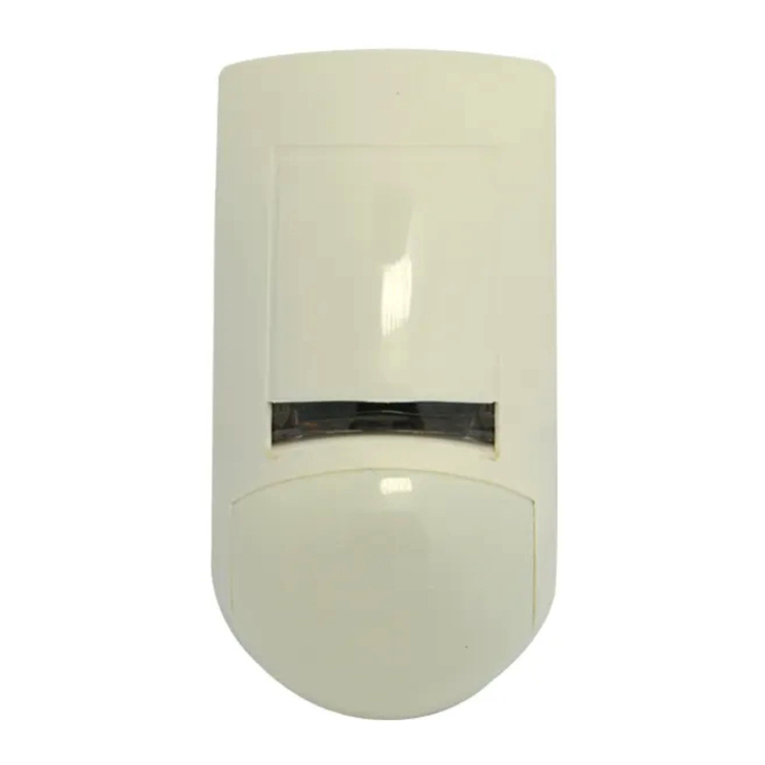
Crow
Crow SRDT-15 User manual
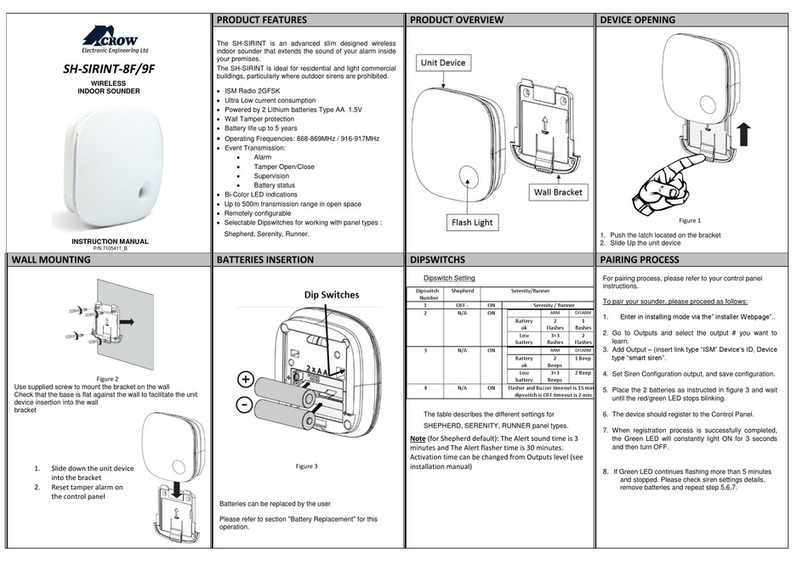
Crow
Crow SH-SIRINT-8F User manual

Crow
Crow SH-SIRINT-8F User manual
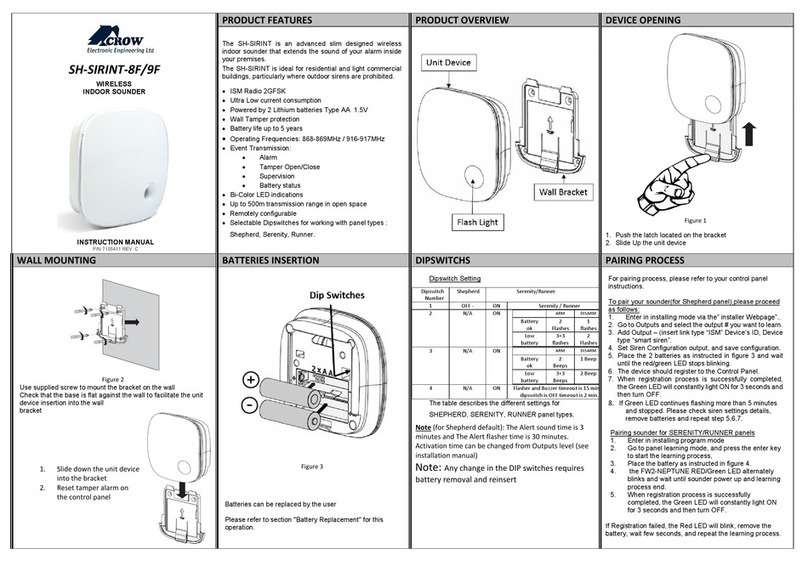
Crow
Crow SH-SIRINT-9F User manual
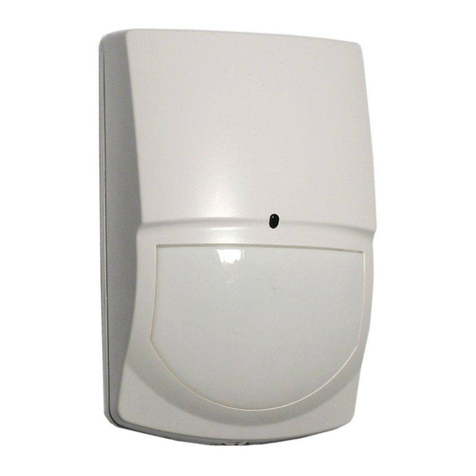
Crow
Crow SWAN QUAD User manual

Crow
Crow MRX-220N User manual
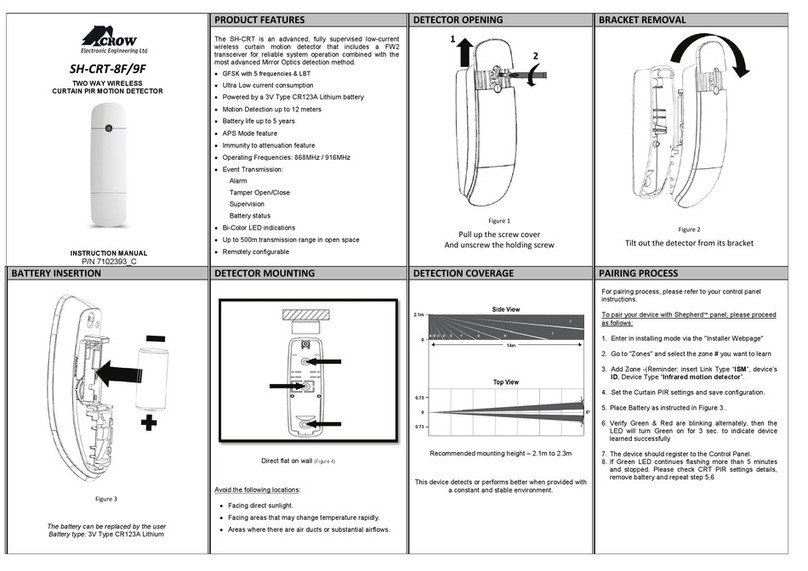
Crow
Crow SH-CRT-8F User manual
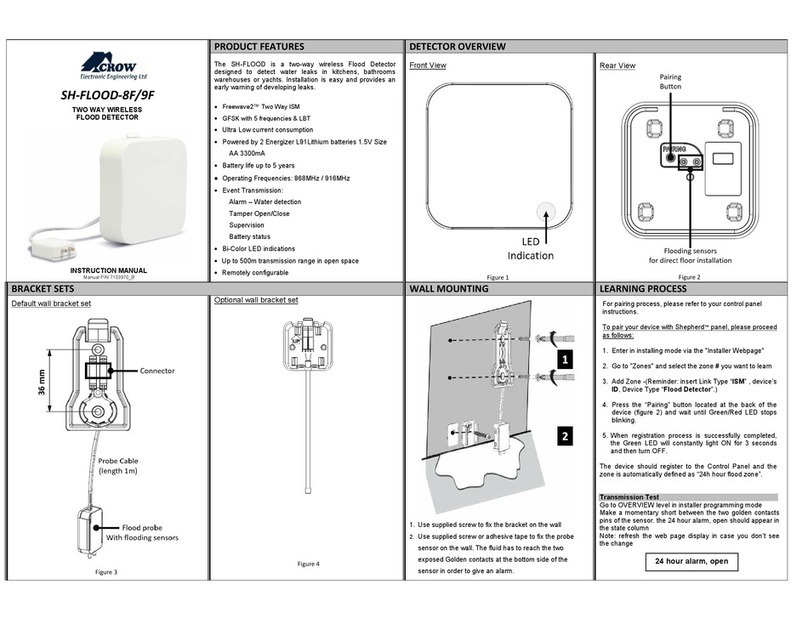
Crow
Crow SH-FLOOD-9F User manual
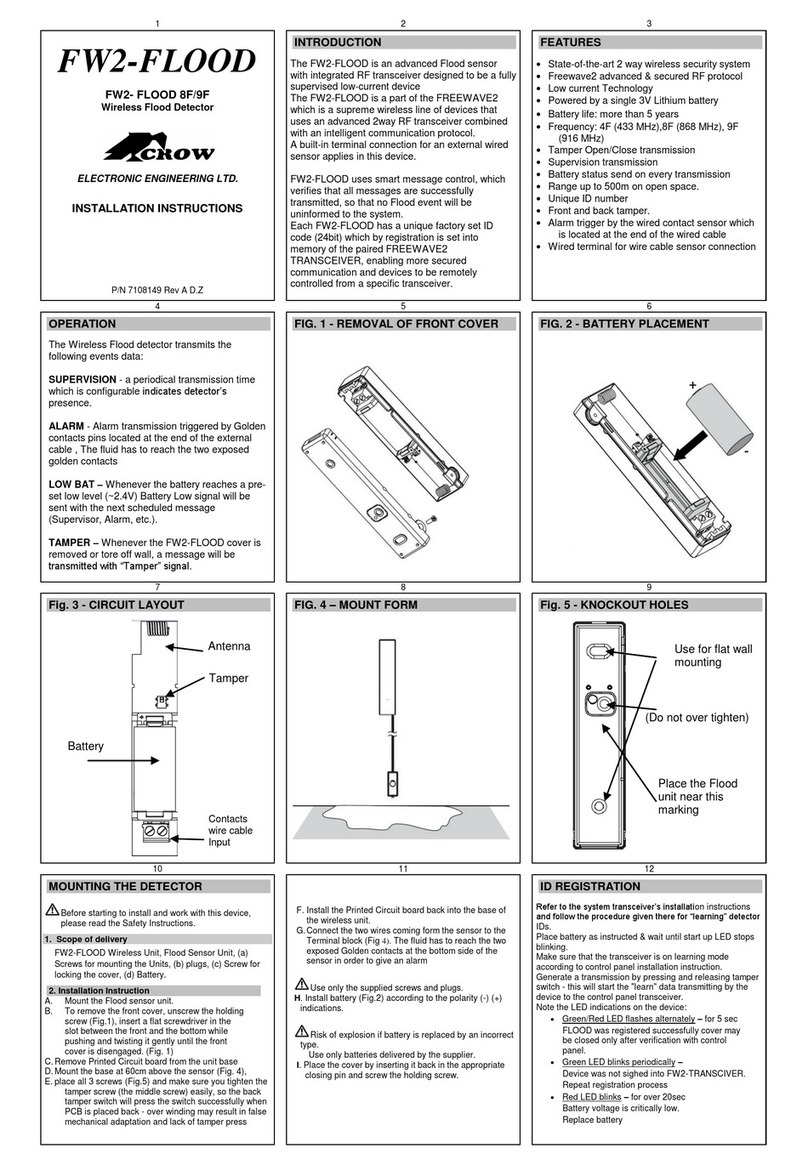
Crow
Crow FW2 FLOOD 8F User manual
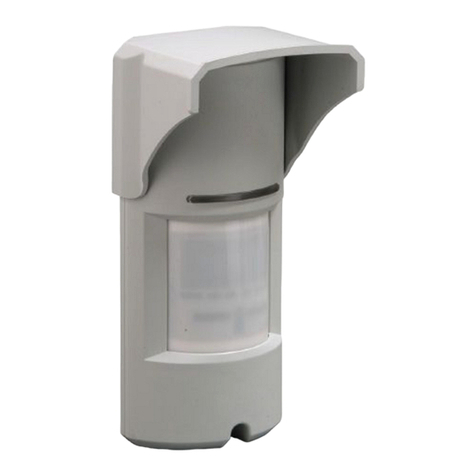
Crow
Crow EDS-2000AM User manual
Popular Security Sensor manuals by other brands
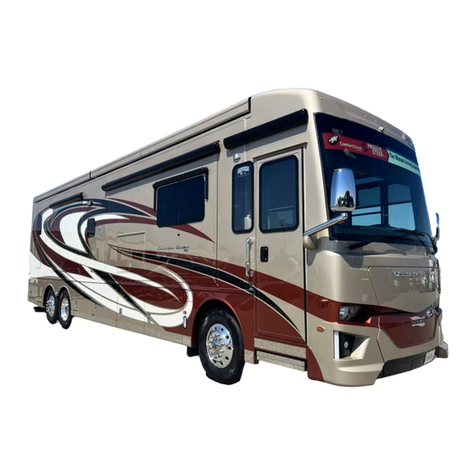
Nice
Nice Silentron Sil Bus 4081 Instructions and warnings for installation and use
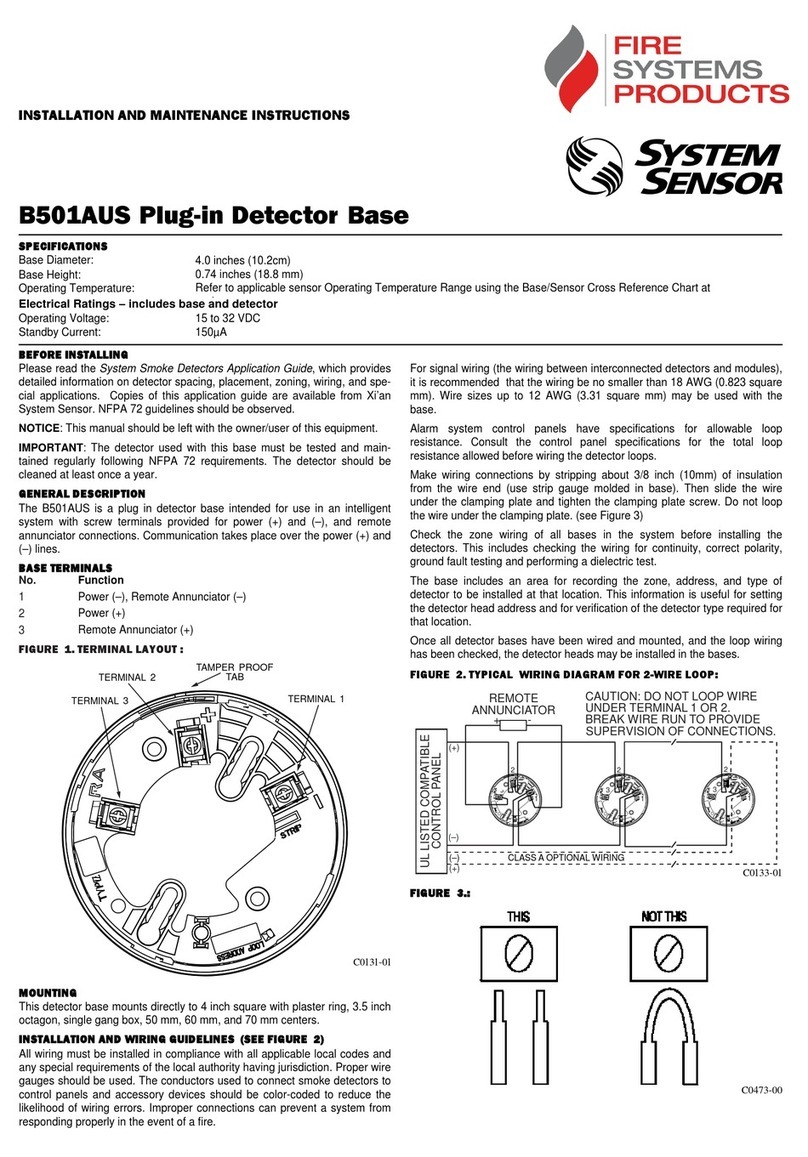
System Sensor
System Sensor B501AUS Installation and maintenance instructions
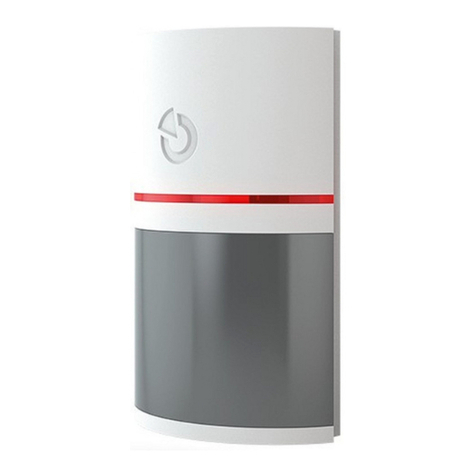
jablotron
jablotron JA-152P quick start guide
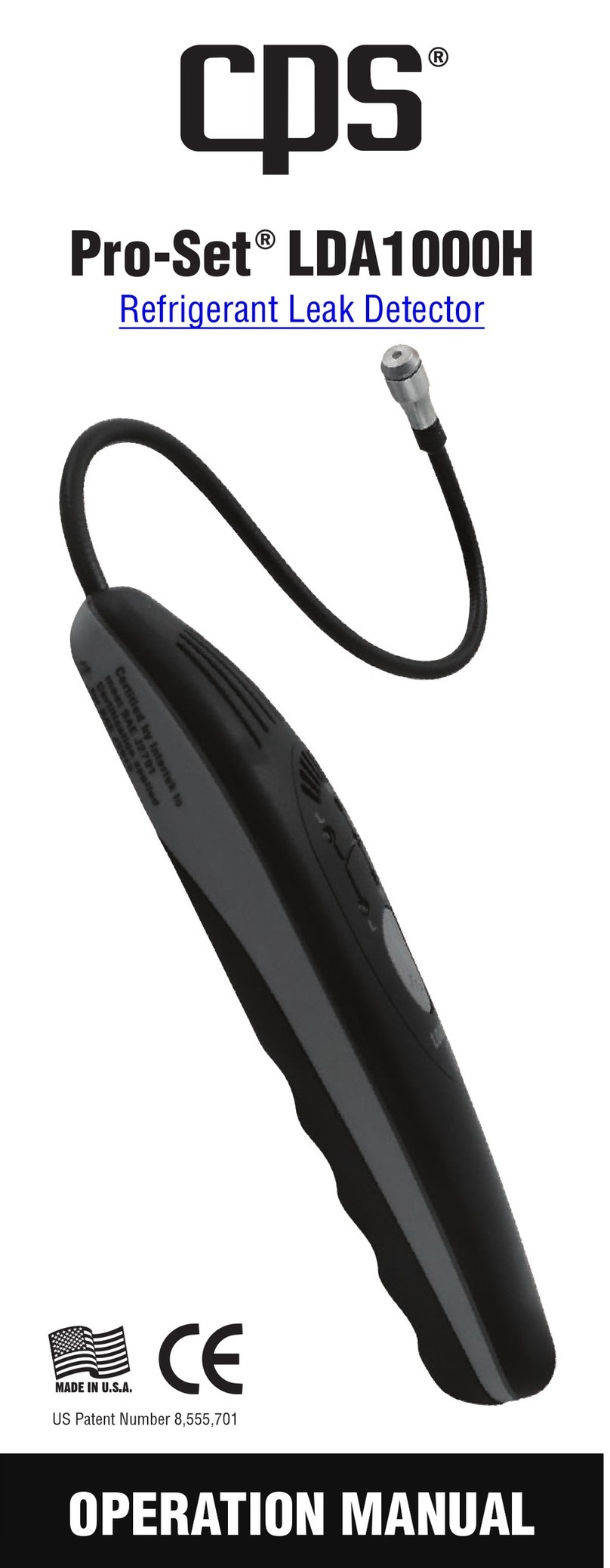
CPS
CPS Pro-Set LDA1000H Operation manual

Aeotec
Aeotec Multisensor Gen5 user guide
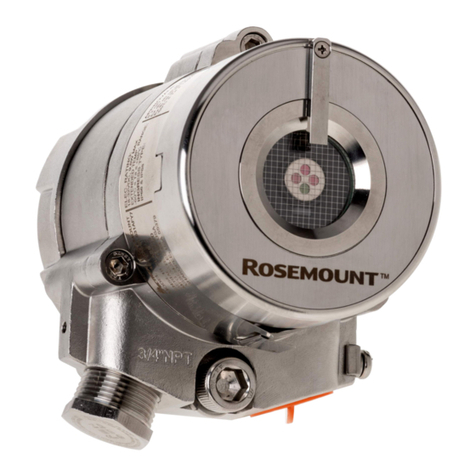
Emerson
Emerson Rosemount 975 Series Reference manual
